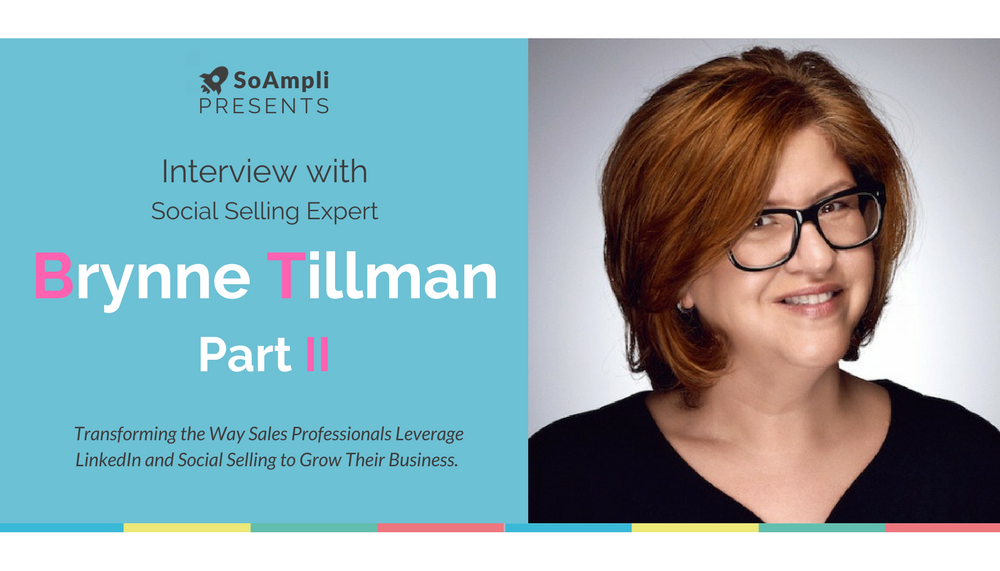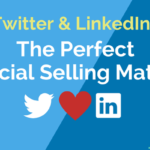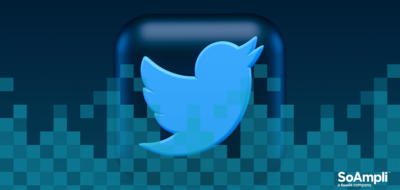Welcome to Part II of our interview with social selling expert and founder of Social Sales Link (now Vengreso) Brynne Tillman.
Brynne had so much wonderful advice to give on social selling, that we had to dedicate the second part of this interview to her actionable advice. Including a rolling out strategy, setting KPIs, and creating a social selling routine…
Q: What’s your advice to companies looking to scale their social selling program?
Rolling out a social selling programme has to be methodical.
So I typically have an 8-step programme:
1. First, you want to define your social selling goals and KPIs.
What are the key performance indicators that are going to measure success for this programme? What are we looking to achieve? Is it more appointments, more opportunities, more brand awareness, get more prospects to download material from the website? We need to define this in a way that will help us measure the success throughout the whole journey.
You need to have the end goal really clear in mind (and this is usually “increase sales”), but then you need to set up specific goals for activities that will help you achieve that goal. What are the activity goals that you can measure? It could be something as simple as “I’m going to ask for 20 introductions from my clients every month”.
2. You then want to create the process.
For instance, let’s say we’re teaching in sales navigator, we will create what is the sales process that we want to take them through. Often this will mirror whatever their current sales process is. How do we scale this process? The only way to do it is to have a consistent process in place.
3. You have to perfect your search filters, beyond just titles.
We need to drill down, and I’m talking specifically about Sales Navigator here, because if you’re going to scale a really powerful programme, your team needs to be on LinkedIn Sales Navigator across the company. On Sales Navigator you have really in depth- search criteria that can give you access to significant data points on targeted prospects, including whether they’ve been active in the last 30 days, which is something great to know when you’re prospecting.
4. Align your LinkedIn Sales Navigator and templates around a current methodology.
If you’re currently using a specific sales methodology, you want to make sure that what you’re going to ask your sales reps to do on LinkedIn is not going to contradict the rest of the strategy.
5. Come up with your list of daily activities.
Based on everything that we’ve uncovered and discovered up to this point, we want to make sure that we are developing and distributing those templates and what to do on a daily basis. This includes engaging and lead activities, asking for introductions, etc. Even the tagging process.
6. Learn to leverage PointDrive.
If you have corporate Sales Navigator, there is a company that LinkedIn bought around a year and a half ago called PointDrive, which is MAGIC. PointDrive is essentially a landing page that you can create and add videos, messages, etc. When you open it, I can then find out how much time you spent on it, what you clicked on, etc. It’s amazing, and that becomes the most valuable data for sales reps when they are prospecting.
7. Leverage original content and native video on LinkedIn
Sharing your own insights and tips or industry trends will really get people to engage with you. Not only people do watch videos quite a lot, but LinkedIn itself is really keen on video right now. If you share a video and it gets any kind of activity, LinkedIn will keep it at the top of your connections’ feed. I had a video that had well over 60,000 views. There is no way that right now I could have gotten that kind of exposure with anything else I publish.
8. Train, measure and tweak as you go
Just knowing how to use a feature or how to do something doesn’t necessarily give you strategy. It’s more than just “Here’s where things are and here’s how you do this”, sales reps need strategy and they need a sales playbook handed to them.
Sales reps are very busy, and have behaviours that are totally engrained into their daily activity, and that’s why they think that social selling is time consuming, because they have to try to fit it in, do this new thing. So, we have to make it as simple as possible and train them in a way that is strategic in nature.
Q: How do you suggest companies measure their social selling ROI?
There are lots of KPIs that we can measure, so when we start working with a company we sit down with them to determine which KPIs will work best for them and how they are going to measure these. Is this going to be measured in their CRM? Or in monthly 1 on 1 meetings with our team? Are we measuring these at the top of the pipeline, or throughout the entire sales process? Every client is very different in this, but there are some key ones that in our experience are effective across the board:
- The easiest KPI, the low-hanging fruit: The increase in the SSI score of your reps on LinkedIn
- The second one: Are your sales reps growing their LinkedIn network with the RIGHT people?
- How many people are converting from new connections to phone calls? This, of course, can be tracked through your CRM, searching for contacts with “LinkedIn” as source of business and seeing how many converted into calls.
- How much engagement are sales reps getting on shared content? You can track this through any social sharing/employee advocacy tool. The leaderboard function is a great way to track this.
- Then, how many client’s referrals are sales reps asking for, and how many are they getting, and how many are converting into connections? This for me is the “warm introduction” category.
As you can see, there are a LOT of KPIs you can measure, but not every company is going to measure everything. You really need to be realistic about what you can manage to track and focus on what you believe will help you drive success. And you need to re-evaluate your KPIs as you go…
Q: Can you walk us through your own social selling routine? Which channels do you find most effective and why?
I actually have a variety of activities with different frequencies: daily, weekly and monthly.
On a daily basis, the thing I find most important is sharing content from my company, but I also have a number of publications I follow that I repurpose content from. I’m probably sharing 7 to 10 times a day and it only takes me 5 minutes a day. Quality is much more important than quantity though, you need to be sharing relevant content that is leading people to you.
On a daily basis, I also spend some time engaging with people in my network; liking, commenting and sharing their content.
I also look into “Who viewed your profile” on LinkedIn to see who is checking me out, do I want to respond to them? Not often, but a couple of times a week I would find someone interesting I want to engage with.
Then I respond to everyone that has accepted a connection request from me and send them a welcome message. After that, I would look into my outstanding connection requests and decide whether or not I want to accept them. When I don’t see why I should connect with a person, I still send them a message, something like: “Thank you so much for connecting with me, typically I only connect with people I know. May I ask how you found me?”.
For my weekly activities, I have to identify which clients I’ll be talking to that week and finding 2 or 3 connections I want to be introduced to. Also weekly, I write on my blog and share it on my LinkedIn.
Monthly, I export my connections into a spreadsheet so that I have those. I will go through to all of my outstanding connection requests and withdraw the ones that haven’t accepted that yet.
To read Part I of this interview, go here.
Catch up on other similar topics, here:







